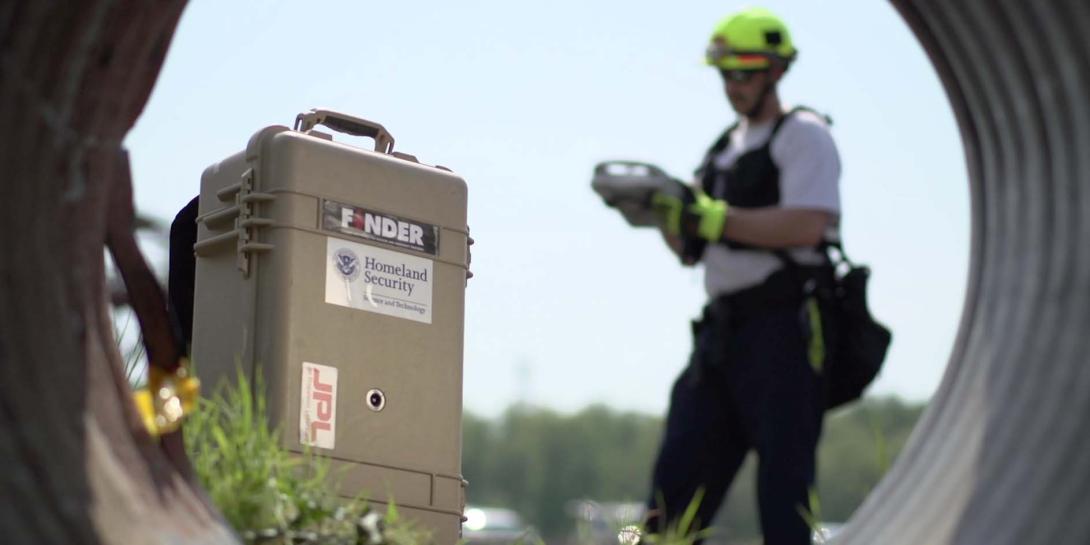Prototype Proves Valuable in Nepal Earthquake Disaster
The Finding Individuals for Disaster and Emergency Response (FINDER) device lived up to its name in Nepal, detecting signs of life that led to the rescue of four men trapped under as much as 10 feet of bricks, mud and other debris following the devastating April 25 earthquake in the area.
FINDER, developed by the Department of Homeland Security’s Science and Technology (S&T) Directorate and the NASA Jet Propulsion Laboratory (JPL), uses microwave-radar technology to detect heartbeats of victims trapped in wreckage. Jim Lux, JPL’s FINDER task manager, credits luck, but it took quick thinking and rapid coordination to ensure FINDER was in the right place at the right time to be helpful.
Lux, who lives in California, receives email alerts about earthquakes, and when he found out about the one in Nepal, he immediately began looking for ways to get FINDER to the region. Over the next couple of days he learned a team from Virginia was being dispatched to Nepal, and some colleagues had a couple of FINDERS in Abu Dhabi, so they were able to coordinate and get the system to the scene. “It was very lucky that we had FINDERS in the right place at the right time,” Lux says. “We’ve field tested for a year in exercises and in rubble piles and everything else, but this was its first outing in a real-deal situation. It’s a little scary—it’s like sending your child out and hoping they do well—and it did.”
The men had been trapped beneath the rubble for days in the hard-hit village of Chautara. David Lewis, president of one of S&T’s commercial partners, R4 Incorporated, Eatontown, New Jersey, arrived in Nepal with two prototype FINDER devices on April 29 to assist in the rescue efforts. He joined a contingent of rescuers from China, the Netherlands, Belgium and members of the Nepali Army in Northern Nepal. Using FINDER, the team was able to detect two heartbeats beneath each of two different collapsed buildings, allowing the rescue workers to find and save the men.
What sets FINDER apart is its ability to detect heartbeats and breathing from long distances and through tons of debris. Lux says the technology will have a wide array of potential uses. “We’re certainly looking at some medical applications. We now have a tool that can read vital signs from a distance, which is very valuable. For instance, think of the recent Ebola cases. You can measure somebody’s heart rate from the other side of a barrier so that you don’t get infected. You can measure vital signs of a victim in a wreck, for example, before they’re extricated, which would be useful also,” he says.
While FINDER already has proven valuable, it is still a prototype with some improvements needed. “The user interface is probably the biggest change. We created a user interface that was functional but not a whole lot more, and there are some aspects about it that I think the manufacturer will improve on,” Lux states.
Additionally, the suitcase-sized system could be made smaller. “We chose that size because we didn’t want to spend too much time trying to get it miniaturized as opposed to getting it to work. We spoke to first responders, and they said the size of a suitcase works for them because during a disaster, everything is palletized, and so if you make it smaller, they’re just going to put it in a case anyway,” he reports. Lux credits first responder feedback with helping to make the prototype effective. “Without that feedback, who would have thought to test the system in the rain and in the dark, even though that’s when a lot of disasters occur,” he asks rhetorically.
The FINDER device will be demonstrated today, May 7, at the Virginia Task Force One Training Facility in Lorton, Virginia. At this event, which was scheduled long before the Nepali earthquake, S&T and JPL will demonstrate the technology with the assistance of members of Virginia Task Force One. They will also announce its official transition to commercial enterprise, where the devices can be manufactured and made available to search and rescue teams around the world.
FINDER has previously demonstrated capabilities of detecting people buried under up to 30 feet of rubble, hidden behind 20 feet of solid concrete and from a distant of 100 feet in open spaces. A new locator feature has since been added to not only provide search and rescue responders with confirmation of a heartbeat, but also the approximate location of trapped individuals within about five feet, depending on the type of rubble.
While it may seem odd for NASA’s JPL to be involved in developing search and rescue technology, Lux says the partnership with S&T occurred through a “series of circumstances,” and he indicated it was actually a natural fit. “Department of Homeland Security was looking for a way to handle large-scale disasters where you’ve got hundreds of structures and you need to be able to quickly look at them and tell which ones have live victims. At JPL, we’re always looking at how to monitor things from a long distance away. About 10 years ago, we were doing some work on measuring heartbeats from a distance using microwave signals. We had experience in remote sensing. That’s what we do.”





Comments